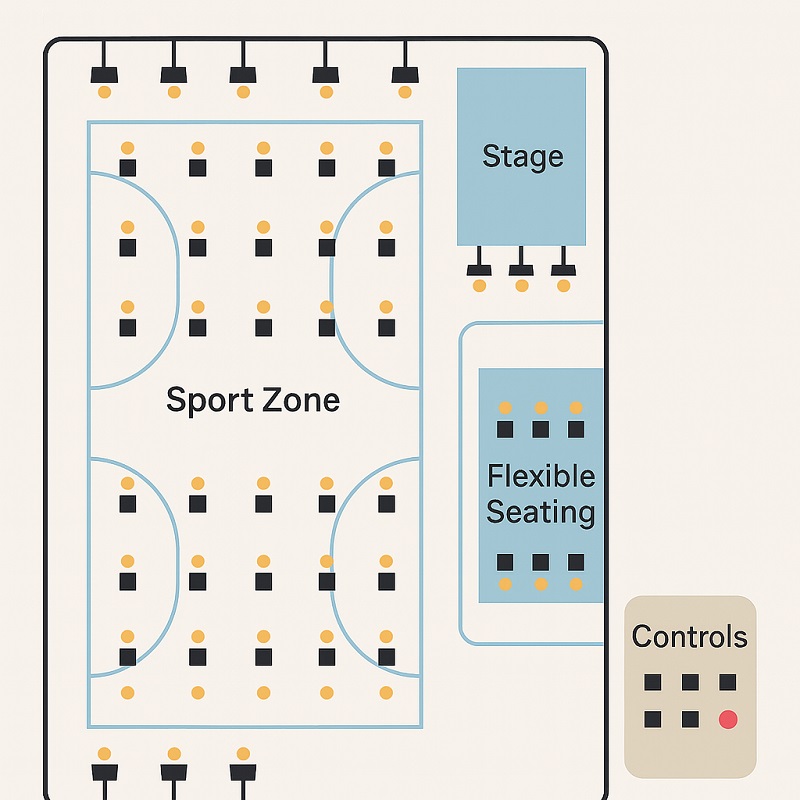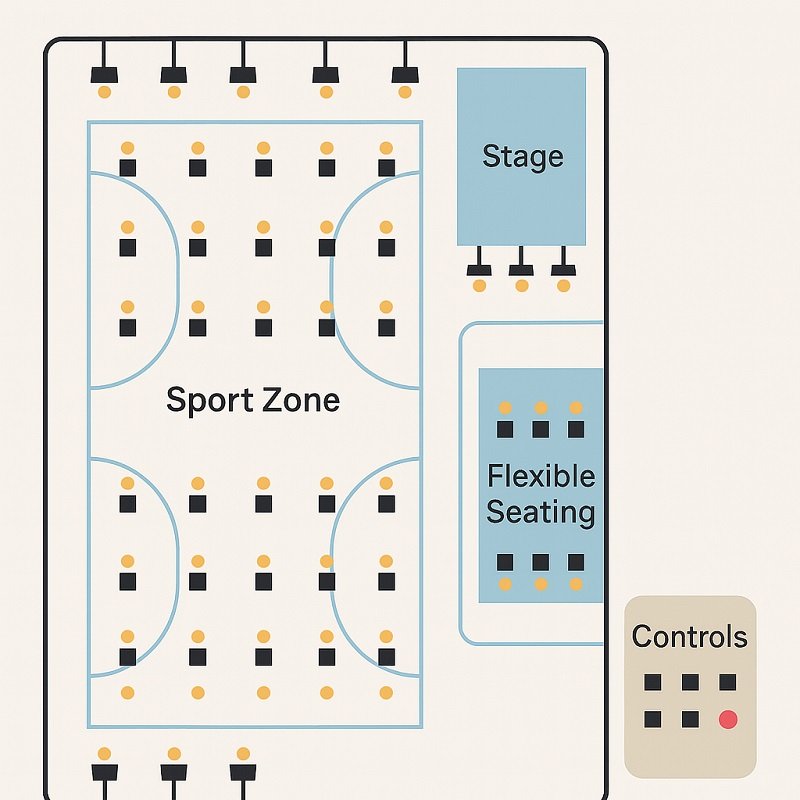Before you choose fixtures or wiring layouts, check out this modern guide to lighting a multi-purpose sports hall so every game, class and event shines. From basketball tournaments to evening yoga and academic exams, these spaces need adaptable lighting that works flawlessly. Good lighting design ensures athlete safety, spectator comfort, camera performance and operational efficiency – all while keeping energy costs down.
Why Lighting Matters in Multi-Use Arenas
Arenas do more than just host games. They’re community hubs for voting, graduations, climbing gyms or exam halls. Lighting must:
- Switch quickly between uses
- Reduce glare on shiny floors
- Maintain even brightness for fair play
- Provide true colour for cameras and judges
- Integrate with smart building systems
When done right, lighting makes every serve, sprint and ceremony a clear and comfortable experience.
Sport-Specific Lux Levels: What You Need to Know
Different sports and activities require varying lighting intensities, measured in lux. Fast-paced sports like handball or basketball demand more brightness than general recreation or meetings.
Recommended Lux Levels (EN 12193 / IESNA RP-6)
| Sport / Activity | Training / Practice | Competition | Broadcast-Ready |
| Basketball | 300–500 lux | 750–1000 lux | 1500+ lux |
| Volleyball | 300 lux | 500–750 lux | 1000+ lux |
| Badminton | 500 lux | 750–1000 lux | 1000+ lux |
| Martial Arts / Yoga | 300 lux | 500 lux | — |
| Climbing / Gymnastics | 500 lux | 750 lux | — |
| Academic Exams | 300–500 lux | — | — |
Install LED arrays with adjustable output to adapt lux levels dynamically—accommodating school assemblies by day and professional matches by night.
Glare for Player Safety
Polished timber floors and shiny surfaces reflect light—causing glare. Here’s how to fix it:
- Mount fixtures 7 meters high
- Optical lenses with 65° beam cut-off
- Matte reflectors to diffuse excess light
- Wall-wash lights to reduce vertical glare on climbing walls
- Glare-control mesh to protect lenses from ball impacts
 Bonus Tip: Aim for a uniformity ratio (UR) of 0.6–0.7 across play areas. No harsh light-to-dark transitions that affect depth perception.
Bonus Tip: Aim for a uniformity ratio (UR) of 0.6–0.7 across play areas. No harsh light-to-dark transitions that affect depth perception.
Colour Quality, Camera Performance & CRI
For visibility and broadcasting:
- LEDs with CRI > 80 for natural jerseys, markings and skin tones
- 4000 K neutral white for balanced light
- Flicker-free output that meets IEEE 1789 for slow-motion replays
Broadcast Standards
For TV events, aim for:
- TLCI (Television Lighting Consistency Index) > 85
- Spectrally stable LEDs
- White balance across zones
Flexible Zoning & Control Systems
Lighting should match the dynamic layout of modern sports halls.
- DALI or DMX digital drivers for zoning control
- Pre-set modes like “match”, “exam” or “gala” via mobile app or wall panel
- Occupancy sensors to dim inactive areas to 10% between sessions
- BMS integration to sync with HVAC and scheduling
Example: One half of the hall can run a yoga class while the other lights a volleyball match—without interference or wasted energy.
If you’re tasked with lighting a multi-purpose sports hall, zoning flexibility becomes one of your most powerful tools. It ensures lighting matches the diverse needs of split-use events, keeps energy usage efficient, and simplifies operations for staff managing daily transitions.
Sustainability and Long-Term Savings
LEDs are the clear winner for performance and energy savings.
- 50–70% electricity savings vs metal-halide lamps
- 100,000 hour lifespan reduces bulb replacement
- Passive infrared sensors and daylight harvesting to trim usage
- Low heat emission eases cooling system load
- Government energy-efficiency grants eligible
Bonus:
- Eco-friendly manufacturing
- Reversible housing
- LCA
Cost vs. Benefit Breakdown
| Lighting Type | Initial Cost | Lifespan | Energy Savings | Maintenance |
| Metal-Halide (MH) | $$ | ~10,000 hrs | Low | Frequent |
| T5 Fluorescent | $$ | ~20,000 hrs | Moderate | Moderate |
| LED Sports Lighting | $$$ | 100,000 hrs | High (50–70%) | Minimal |
ROI Tip: Most LED upgrades pay for themselves within 3–5 years, especially with subsidies or grants.
 Lighting for All Users
Lighting for All Users
Good lighting design doesn’t just support athletes, it also supports safety and comfort for:
- Visually impaired visitors
- Older spectators
- Adaptive and inclusive sports participants
Make sure:
- Even lighting with no dark spots
- Low-glare, flicker-free light
- Color consistency for better depth perception
Example: Community Centre Upgrade
Brighton Leisure Centre upgraded its 15 year old lighting system:
- Replaced 38 metal halide fixtures with 24 LED high-bays
- Installed DALI control panel with 3 pre-sets
- Added daylight harvesting near clerestory windows
- Annual energy savings: $8,200
- ROI in 2.6 years
- Improved broadcast quality for local tournaments

 Key Points
Key Points
- Plan lux levels by activity type using EN/IES standards
- Control glare and color accuracy for players and cameras
- Use zoning for flexibility and efficiency
- Go LED for big savings and sustainability
- Design inclusively for all users, not just athletes
- Use incentives to reduce capital costs and fast track payback

